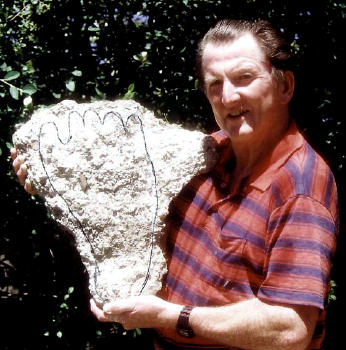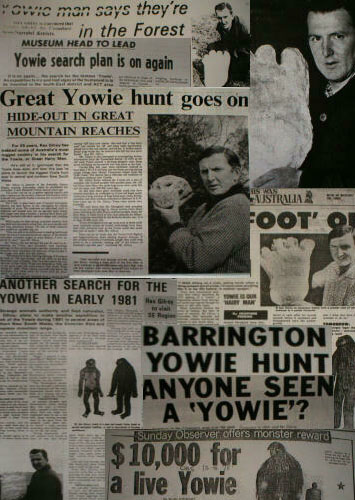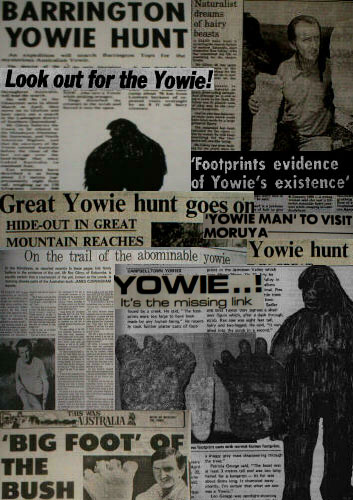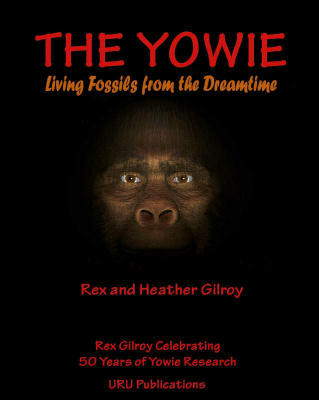Rex Gilroy 50 Years of Research
This article is composed of extracts from the 2007 book:
“The Yowie Mystery - Living Fossils From The Dreamtime".Copyright (c) 2007 Rex Gilroy, Uru Publications.
Many people believe that I only attained the “Yowie Man” title in the mid-1970s after the major newspapers ‘discovered’ my researches. Actually I was given the title by radio announcers after initial interviews on the former Blue Mountains Radio Station 2KA at Katoomba. Thus the title “Rex the Yowie Man” goes back to as early as the beginning of the 1960s. In more recent times my title has been plagiarised by a certain ‘gentleman’ who uses it to promote himself through newspaper and television ‘stunts’.
Despite his boasts to have “learnt more about the Yowie in four years than Rex Gilroy has in 45 years” [as bragged on one American radio station interview] he is in no way a scientific investigator. Indeed, he and his kind have done nothing but help bring discredit upon the very sciences of relict Hominology and Cryptozoology that they claim to be ‘experts’ or ‘world authorities’ on. Despite the fact that these people continue to do their best to slander and discredit my lifetime’s dedicated research [which for the past 33 years has included my wife Heather], I will not name them, as this would lower me to their level! Heather and I believe we have this evidence; evidence that is far more scientific. We challenge our ‘big mouth’ opponents to put their own evidence where their mouths are or else shut up!
Looking back over my 50 years of research on the Yowie mystery, I see an evolutionary pattern in my work, beginning with the youthful enthusiasm of a teenager gathering old Aboriginal and early settlers stories of encounters in the bush with the “hairy man”, to the beginnings of my earliest field investigations and footprint finds; how I at first believed that the “hairy man” was some form of long-haired bipedal primate, which might be a surviving population of Gigantopithecus blackie which had made its way into Australia during the Pleistocene period.
Yet I eventually realised that the cast footprints of the Yowie that began appearing in the 1960s, and also those recovered during the early 1970s, were more hominid than primate. At the same time I was beginning to uncover recently-manufactured crude stone implements from remote areas of the Blue Mountains. These, together with Aboriginal accounts of the “hairy men and women” being able to make fire and cook their food, soon led me to realise that I was dealing with remnant populations of living Homo erectus. This belief was meanwhile being reinforced by discoveries first with my late father Mr W F [Bill] Gilroy, and later by me and my wife Heather, of actual fossil skull-types of Homo erectus over a wide area of Australia, mostly in areas once inhabited by the “hairy people” according to Aboriginal traditions.
I learnt also that ‘Yowie’ was but one of many, indeed a great many names throughout Australia, by which these beings were known to our Aborigines. In fact, I discovered that these names all identified any non-Aboriginal race with which they once shared the continent, be they average modern human height beings, pygmies or giants. All these names meant “hairy man”, “hairy woman” or “hairy people”, and they were all called such not because they possessed long body hair, but because they wore cloaks of kangaroo and other marsupial [fur] hides, just like the Aborigines in early historical photographs which can still be seen today.
Thus as my information and evidence grew I was able to discard previous ideas on the physical appearance and identity of the Yowie.
A similar evolution of my theories, both on the origins of the Yowie and of pre-Aboriginal hominid evolution as a whole, can be seen in the way that my ideas have changed over the years as my collection of fossil hominid skull-types grew. In September 1969 I recovered a 52mm tall giant hominid lower back premolar tooth at a fossil site now covered by Westmead Children’s’ Hospital in Sydney’s west. The discovery of my first giant hominid fossil footprint followed in April 1970 at Mulgoa, at the eastern base of the Blue Mountains.
Then in May 1972 my late father found the mineralised endocast of a large ‘archaic’ Homo sapien skull at an old Pleistocene site at Tarana, just west of the Blue Mountains; followed by my own discovery of a smaller endocast of a ‘late’ Homo erectus skull-type about 30 metres away in the same strata, demonstrating upon various grounds to be discussed further on in this book, that Homo sapiens were already present in Australia by 300,000 years ago, and that they shared the land with their ‘father’ Homo erectus. Another, ‘archaic’ Homo sapien fossil, a skull cap recovered by me at Katoomba in November 1974, showed that Homo sapiens dated back at least 400,000 years.
It had by now become clear to me that modern humans had not evolved first in Africa [where their earliest fossils date around 200,000 years BP] but right here in Australia from Homo erectus. Just how long ago Homo erectus had first appeared on this continent began to be revealed in the years ahead, when Heather and I discovered an ‘archaic’ Homo erectus incomplete mineralised skull outside Mudgee, deep in the New South Wales Central West, in June 1997 and which on various grounds I dated between 800,000 to 1 million years BP.
As the earliest Homo erectines would have entered Australia from South-east Asia [I reasoned at the time], then the earliest fossil evidence had to lie hidden in our far north. This view was I thought finally vindicated by the discovery of an ‘archaic’ [ie flattish skull] Homo erectus skull-type, on the Flinders River in Queensland’s Gulf Country in October 2002. Photograph right: Aboriginal Girl wearing a Kangaroo hide Garment. Photographer Unknown. I will credit anyone who owns this photograph.
While these discoveries were taking place, Heather and I had discovered a number of fossil hominid footprint sites, preserved by ancient volcanic ash deposits, in the Katoomba district and further to the south-west, deep in the Kanangra Boyd National Park. Depending upon the different volcanic eruptions and ages involved, these fossils of anatomically modern human appearance in many cases, vary from around 1 to 2, even 3 million years BP! All this evidence will be fully described in the chapters ahead, but the reader can see that I have, in a scientific manner, altered my previous views as new evidence came into my hands. Unfortunately for my opposition, they are unable to change their approach and will continue to hunt for “hairy monsters” that have no place in scientific reality
Although my researches into the Yowie can be traced back to the late 1950s and I had done a number of radio interviews on the subject during the 1960s, it took the press, and Australian media as a whole, well into the 1970s to ‘discover’ my work and subsequently, to my growing horror, turn the “hairy man” into a comedy relief gimmick at my expense! Every newspaper article I wrote was distorted by reporters, and every magazine feature article written by me could not escape tongue-in-cheek retitling from my original heading. It became virtually impossible for me to present a scientific picture on the mystery.
Thus my early television interviews were likewise turned into a farce, and ‘live’ interviews were done by day or night time hosts who could not ask me even one sensible question, treating the interviews as nothing more than comedy relief for mindless viewers. In the end I gave up and refused all offers of television interviews on the subject. Only after three years did I agree to once more give interviews on the condition that I be asked sensible questions. This resulted in some improvement.
As I have said in our previous book on the Yowie, I put up with a lot of ridicule from the media and scientists alike. I made the road ahead easier for those that followed me. Unfortunately those that followed me have done all they can to rob me of my rightful place as the ‘father’ of these sciences. Their activities are not only dishonest but un-Australian. It is the “tall poppy” syndrome at work again, a syndrome we can well do without!
I do believe that my fifty years of Yowie [ie relict hominid] research speaks for itself. One cannot claim to have ‘experience’ or be able to speak with ‘authority’ with barely a few years of “Yowie hunting” with television crews in tow. This is not research. Therefore, what Heather and I offer the intelligent, reasoning reader, is a scientific investigation of the Australian relict hominid mystery. In proving Homo erectus as the origin of the “Hairy man” we believe that we have solved the mystery of the Yowie. We now invite the reader to judge our evidence for themselves.
“The Yowie Mystery - Living Fossils From The Dreamtime".
“The Yowie Mystery - Living Fossils From The Dreamtime". Special Dedication. The Authors dedicate this book to the late Charles Melbourne Ward F.Z.S.; F.R.Z.S. known to his great many friends simply as ‘Mel’. Together with his wife Halley, he operated a natural history museum in the grounds of the Hydro Majestic Hotel at Medlow Bath for many years and also another established at Echo Point, Katoomba. It was ‘Mel’ who first taught me how to collect, record and study natural history specimens, beginning when I was aged 11 years old on holidays with my parents at Katoomba in 1954. Thereafter, every school holidays spent in Katoomba began with a visit to ‘Mel’ at his Medlow Bath Museum to inform him how my fledgling natural science studies were progressing!
As a result and after my parents moved from our Lansvale [western Sydney] home to Katoomba, the Gilroys and Wards became close friends. There was hardly a week which did not see me peddling my pushbike from our North Katoomba home up the Great Western Highway to see ‘Mel’ at his museum for more instruction. Mel Ward possessed a wide knowledge of the culture of the Australian Aborigines and that of the former local Blue Mountains tribes in particular.
He was also a firm believer in the “Hairy Man” and supported my researches in this regard. At my 21st birthday party, held at the Homesdale Function Centre, at Katoomba on Saturday night 8th November 1964, I well recall how my old friend, in front of a large gathering, congratulated me on my researches and the large natural science collection that I was forming and then said: “You’ve done a fantastic job Rex, BUT IT’S ABOUT TIME THAT YOU STARTED MAKING SOME BLOODY MONEY OUT OF IT” in a loud voice that brought the house down!
That following week, together with my father Mr W.F. [Bill] Gilroy, I began a search of local venues, which soon resulted in the acquisition of the lease from the Blue Mountains City Council of the Mt York Tea Rooms, outside Mt Victoria, the rest they as “is history”. Two years late, on October 6th 1966, Mel Ward was dead, having passed away in his sleep. He once said to my father that I was “the Mel Ward of Tomorrow” and I am certain that Mel would be pleased to know that I have indeed followed in his footsteps.
Mel led an adventurous life. The son of Hugh J. Ward, a famous Shakespearean actor of the early 20th century, Mel was encouraged to go on the stage by his father but Mel developed a passion for the natural sciences and his wealthy parents helped him become established. In his lifetime of achievement, Mel became recognised as a world authority on Crustaceans and an anthropologist. He was made a Fellow of the Royal Zoological Society of New South Wales and was pleased when I too became a member of the Society in 1963. He encouraged me, not long before his death, to take on the Presidency of the Society’s Entomological section, where I served for three years from 1966 to 1969.
That he achieved so many things in the course of his lifetime researches is remarkable, because like this author, he was an amateur with not one university degree to his name! I am certain that my old friend would be delighted at the fact that, together with heather, I am now writing and publishing book on the subjects he loved and on the Yowie in particular. He taught me never to blindly follow the textbook and dare to question dogmas and not be told what to think! I have certainly followed his advice. Knowing Mel Ward as I did I know he would wholeheartedly approve of the scientific approach of this book, therefore “Mel”
This Book is for You!
Rex Gilroy - Australian Yowie Research Centre, Katoomba, NSW.
Monday 25th June 2007I also present sensible advice to any future would-be Yowie investigators. The reader will also be awed at the great many discoveries my wife Heather and I have made in all our years together in the field. I feel privileged to be the founder of Yowie research and to have encouraged other, sensible researchers to follow my example. The search for surviving relict hominids in remote, hidden regions of the world, has been called the “last great search”, and it is both a fascinating and exciting one. Rex Gilroy may be contacted at the Australalian Yowie Research Centre, PO Box 202, Katoomba. NSW 2780. Ph 02 4782 3441 or email New Email Address as of June 2009 randhgilroy44@bigpond.com on or visit our website : http://www.mysteriousaustralia.com/ or http://www.australianyowieresearchcentre.com/ or http://www.rexgilroy.com/
Newspaper Articles on Rex Gilroy's Lifetime Search for the Australian Yowie
Newspaper Articles on Rex Gilroy's Lifetime Search for the Australian Yowie
Aboriginal/Koori Names for the Australian Yowie
To present the Yowie mystery in its proper context, relict hominid evidence from south-east Asia, New Guinea, other west Pacific Islands and New Zealand is revealed, demonstrating how the ancestors of these ‘manimals’ once spread out across the earth via land-bridges that formerly joined Australia/New Guinea/New Zealand with what is now island south-east Asia to the Asian mainland.
“Hairy man” was a name given by the Aborigines to any non-Aboriginal race with which they shared this continent, but the term centred primarily upon at least three basic forms. These forms were either the height of an average human being, an enormous man-like and also ape-like form. All were known by different names Australia-wide, but all meant either “hairy man” or “great hairy man”.






